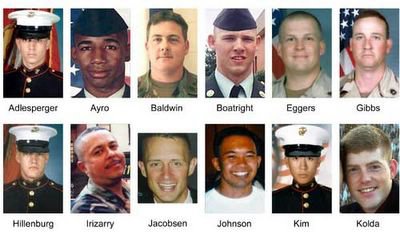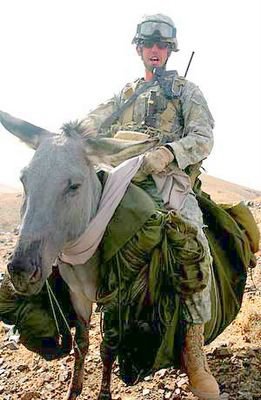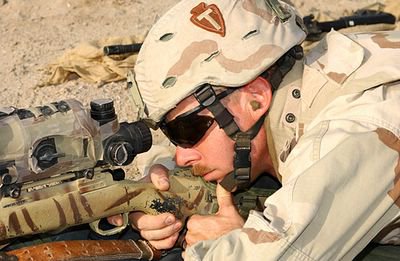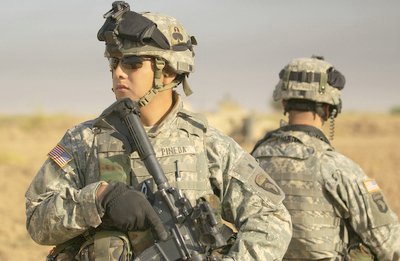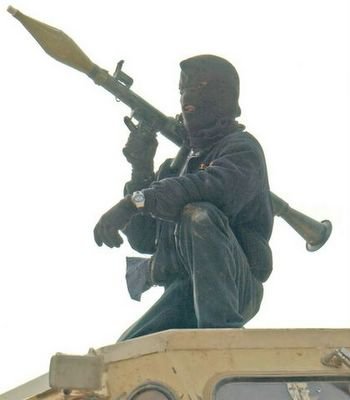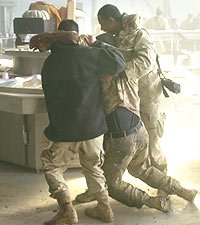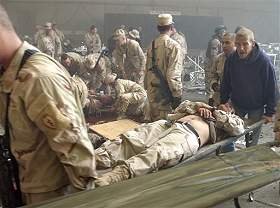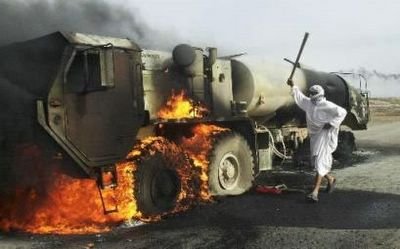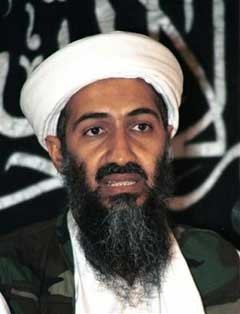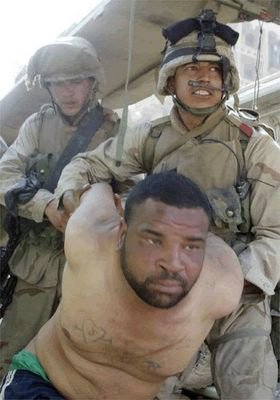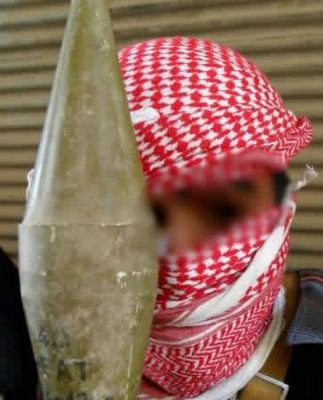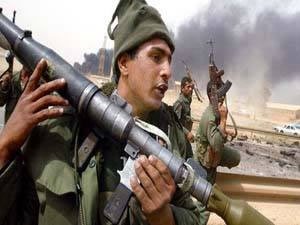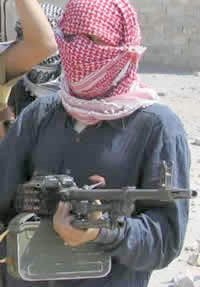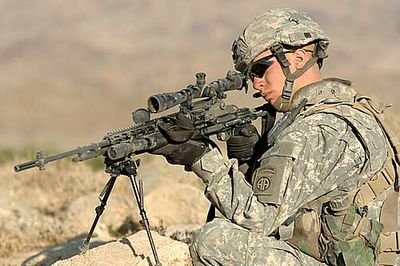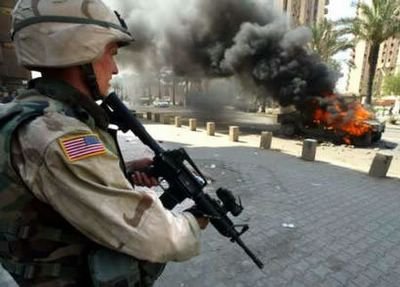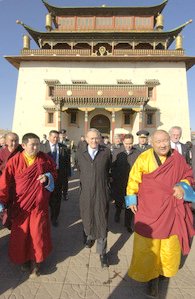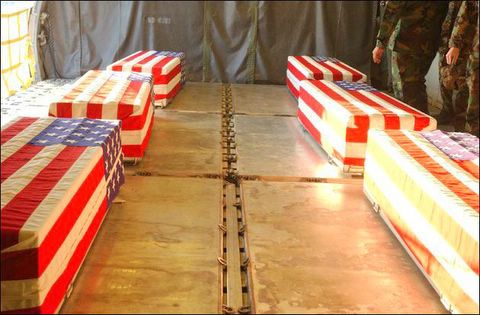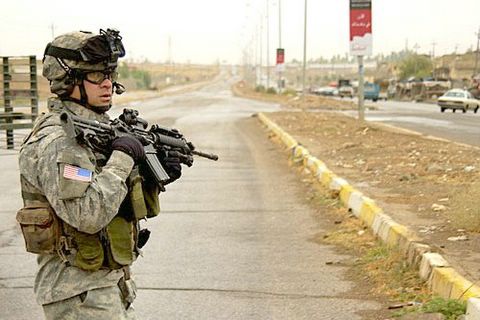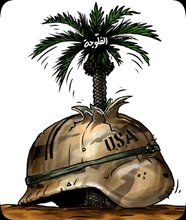Monday, October 31, 2005

This weapons cache was found in a house during a major operation conducted by U.S. soldiers from 1st Battalion, 184th Infantry Regiment, and Iraqi security forces from the 4th Public Order Brigade in eastern the eastern part of Baghdad's Rasheed district Oct. 28. The cache was hidden in a crawlspace found underneath a bathtub. Army photo

Roadside Bombs Claim Lives of Six Soldiers, Two Marines
American Forces Press Service
WASHINGTON, Oct. 31, 2005 � Four U.S. soldiers from Task Force Baghdad were killed today when their vehicle struck a roadside bomb in the Yusufiyah district, southwest of Baghdad, military officials reported today.
Another roadside bomb killed two 29th Brigade Combat Team soldiers today while they were on a patrol north of Logistics Support Area Anaconda, officials said.
Elsewhere, a U.S. Marine died when his vehicle struck a roadside bomb near Amiriyah Oct. 30. The Marine was assigned to the 2nd Force Service Support Group (Forward), 2nd Marine Expeditionary Force (Forward).
Another Marine died when his vehicle hit a roadside bomb near Nasser Wa Salaam Oct. 29. The Marine was assigned to Regimental Combat Team 8, 2nd Marine Division, 2nd Marine Expeditionary Force (Forward).
The names of the soldiers and Marines are being withheld pending notification of next of kin.
In other operations in Iraq, a Saudi-born al Qaeda operative who was involved in smuggling foreign fighters into Iraq was killed Oct. 29 as he attempted to flee coalition forces. Coalition forces killed Abu Saud and three other terrorists when they tried to escape in a vehicle. Officials said multiple intelligence sources and tips from concerned citizens led coalition forces to the terrorists' location near Ubaydi.
Intelligence sources believe Saud recently arrived from Saudi Arabia to shore up the leadership of terrorist cells whose previous leaders have been captured or killed in recent months, officials said.
Coalition forces were told a meeting was being arranged in the coming days in which Saud was to take control of facilitating foreign fighters in the Qaim and Husaybah regions. Officials also believed that Saud would take on a more active role in the planning and execution of operations against coalition forces, officials noted.
Elsewhere, Task Force Baghdad soldiers caught a terrorist Oct. 29 as he tried to plant a roadside bomb in an Abu Ghraib neighborhood about 20 miles west of Baghdad, officials said. The soldiers shot and killed the terrorist, who was suspected of placing and detonating roadside bombs against Iraqi army units in eastern Abu Ghraib, officials said.
Soldiers from the 1st Squadron, 11th Armored Cavalry Regiment, saw the terrorist as he rode up on a bicycle and emplaced what looked like a bag with suspicious wires coming out of it. The soldiers determined that the suspicious bag was a bomb and shot and killed the terrorist. The bomb exploded moments after the terrorist was shot, but no damage or injuries were reported. Another bomb was found on the terrorist's bicycle and was later destroyed by ordnance disposal experts.
Task Force Baghdad soldiers and Iraqi security forces nabbed 49 terrorists and a large weapons cache during major combat assaults dubbed Operation Clean Sweep Oct. 28-29 south of Baghdad, officials said.
U.S. soldiers from the 1st Battalion, 184th Infantry Regiment, teamed with Iraqi forces from the 4th Public Order Brigade and swept through the eastern part of the Rasheed district Oct. 29. The multi-pronged assault resulted in more than 350 target houses searched and the detention of 33 suspected terrorists. The troops also found bomb-making materials at several of the target houses.
In an earlier mission Oct. 28, 1st Battalion, 184th Infantry, soldiers detained 16 terror suspects and discovered a large weapons cache during a cordon-and-search operation, officials said. The cache was hidden in a second-story crawlspace underneath a bathtub and included 13 AK-47 assault rifles, three MPK machine guns, 20 AK-47 barrels, a pistol, U.S. currency and an ammunition stockpile.
Acting on information from a citizen in Tal Afar, Iraqi police uncovered the bodies of 14 people buried in a shallow grave just east of the city in western Ninewa province Oct. 28. Twelve of the corpses were bound and appear to have been shot in the head execution-style. Two others were decapitated, officials reported. Officials said the individuals appear to have been dead for one to three months.
In the past month, Iraqi and U.S. forces have uncovered other grisly evidence of how terrorists maintained a grip of fear over the population of Tal Afar, officials said.
Terrorists used the city to train mortar teams and then conducted attacks against innocent civilians. In the most recent attack, two girls, 9 and 11, were injured when two mortar rounds impacted in front of their house as they played outside. Iraqi forces provided first aid, and U.S. forces evacuated the 11-year-old to a Mosul hospital for treatment, officials noted.
Terrorists in Tal Afar are using boys and women to conduct attacks against security forces and the people of Tal Afar, officials said. Officials attribute this to the 3rd Armored Cavalry Regiment and the 3rd Iraqi Army Division's effective security operations.
Recently, a young boy with a learning disability was coerced into throwing hand grenades at local citizens and Iraqi security forces. U.S. soldiers captured the boy, who led them to the 60-year-old man who instigated the attack. The man was captured, and U.S. forces are working with Iraqi officials to find foster care for the boy.
In the past month, four other incidents of boys age 10 to 12 conducting attacks have occurred. Three involved hand grenades, and one killed an Iraqi civilian who had previously told the children to stop these attacks.
In a chilling confession, one boy, who Iraqi police captured during the heavy fighting in September, admitted to murdering people and even helping hold the feet of others while older terrorists beheaded them. The boy had been sodomized and brainwashed by the terrorists, officials said.
Despite the cultural and religious taboos, terrorists also continue using women to attack security forces.
In late September, a woman believed to be in her early 20s and also mentally impaired detonated an explosive belt, killing herself and seven other innocent Iraqis, including one child.
Other instances of women assisting terrorists either by force or willingly have been documented. Employing female searchers, Iraqi forces have found women hiding cell phones and weapons in their clothing
In the air war over Iraq, coalition aircraft flew 36 close-air-support and armed-reconnaissance sorties Oct. 30 in support of coalition troops, infrastructure protection, reconstruction activities and operations to deter and disrupt terrorist activities.
U.S. Air Force all-weather F-15 Eagle tactical fighters performed air strikes against insurgent forces near Karabilah. The F-15s dropped a precision-guided bomb and destroyed enemy targets, officials noted.
Other Air Force F-15s and F-16 Fighting Falcons, a Predator and Royal Air Force G-7s provided close-air support to coalition troops near Balad, Basra, Salman Park and Tacit.
In addition, 10 Air Force and Navy intelligence, surveillance and reconnaissance aircraft flew missions in support of operations in Iraq. British Royal Air Force fighter aircraft performed in a nontraditional ISR role with their electro-optical and infrared sensors.
(Compiled from Task Force Baghdad, Multinational Force Iraq, and U.S. Central Command Air Forces Forward news releases.)

Coalition Forces Disrupt Ambush; U.S. Engineers Find Roadside Bomb
American Forces Press Service
WASHINGTON, Oct. 30, 2005 � Coalition forces foiled a terrorist ambush in an area northwest of Baghdad late Oct. 29, military officials reported today.
The coordinated combat operation against the terrorist forces involved U.S. Army ground and aviation forces and close-air support from a U.S. Air Force F-15E, which dropped a 500-pound precision-guided bomb on the enemy position.
The area was known for multiple ambushes with small arms and rocket-propelled grenades against local Iraqi citizens, Iraqi security forces and coalition forces, officials said.
Around 9 p.m., a group of terrorists was spotted moving along a canal and getting into position for an ambush. As ground forces from 3rd Brigade, 1st Armored Division, secured the area around the ambush site, attack helicopters arrived at the scene and confirmed that the individuals hiding in the bushes were enemy forces.
When the terrorists fired at the helicopters, the AH-64 Apaches engaged them with return gunfire.
Several enemy forces retreated into a nearby house, but later fled the premises as U.S. forces moved in.
The Apache helicopters continued to engage the terrorists as they scattered and tried to hide in vegetation. When several terrorists converged in one location, ground forces called in the F-15E air strike.
Coalition forces killed at least six terrorists in the combat operation, and wounded and detained five others. No U.S. or civilian casualties were reported.
In other operations in Iraq, Task Force Baghdad soldiers discovered a roadside bomb northwest of Baghdad on the evening of Oct. 28.
Combat engineers from 36th Engineer Group discovered the hidden improvised explosive device before it could be used to harm Iraqi security forces, Iraqi civilians or coalition forces.
Soldiers from 70th Engineer Battalion, 3rd Brigade, 1st Armored Division, quickly secured the site after the discovery. An explosives ordnance disposal team recovered the bomb.
(Compiled from Task Force Baghdad and Multinational Force Iraq news releases.)
Saturday, October 29, 2005

Iraqi children in the city of Mosul clamor for soccer balls from the U.S. soldiers of Company A, 4th Battalion, 23rd Infantry Regiment, 172nd Stryker Brigade Combat Team, Fort Richardson, Alaska, during the company's patrol of Mosul in the Stryker light armored vehicle, Oct. 20, 2005. U.S. Army photo by Spc. Jeremy D. Crisp
Friday, October 28, 2005

A flock of ducks attempts to waddle through a Stryker light armored vehicle patrol on the outskirts of Mosul, Iraq, Oct. 20, 2005. U.S. soldiers of Company A, 4th Battalion, 23rd Infantry Regiment, 172nd Stryker Brigade Combat Team, Fort Richardson, Alaska, conducted the patrol. U.S. Army photo by Spc. Jeremy D. Crisp
LATE-NIGHT EXPLOSION LEADS TO EARLY MORNING ARRESTS
LATE-NIGHT EXPLOSION LEADS TO EARLY MORNING ARRESTS
BAGHDAD, Iraq -- Iraqi and U.S. Soldiers detained 20 terror suspects and confiscated bomb-making materials during an early morning cordon and search in the Dora neighborhood Oct. 27.
While responding to an unexploded improvised explosive device found in the area, Soldiers from 1st Battalion,184th Infantry Regiment, 4th Brigade Combat Team heard an explosion about 200 meters from their location shortly before midnight Oct. 26.
The Soldiers moved in to investigate the cause of the blast and found 19 men along with assorted IED-making materials in a house. Iraqi security forces from 1st Battalion, 4th Public Order Brigade assisted 1-184 Inf. during the operation and detained the men for further questioning.
The IED-making materials consisted of a voltage regulator along with battery packs. An explosives ordnance disposal team conducting the post-blast analysis determined that 60 pounds of explosives were used during the explosion which destroyed one quarter of the house.
The owner of the house was later detained as a suspect involved in the explosion.
BAGHDAD, Iraq -- Iraqi and U.S. Soldiers detained 20 terror suspects and confiscated bomb-making materials during an early morning cordon and search in the Dora neighborhood Oct. 27.
While responding to an unexploded improvised explosive device found in the area, Soldiers from 1st Battalion,184th Infantry Regiment, 4th Brigade Combat Team heard an explosion about 200 meters from their location shortly before midnight Oct. 26.
The Soldiers moved in to investigate the cause of the blast and found 19 men along with assorted IED-making materials in a house. Iraqi security forces from 1st Battalion, 4th Public Order Brigade assisted 1-184 Inf. during the operation and detained the men for further questioning.
The IED-making materials consisted of a voltage regulator along with battery packs. An explosives ordnance disposal team conducting the post-blast analysis determined that 60 pounds of explosives were used during the explosion which destroyed one quarter of the house.
The owner of the house was later detained as a suspect involved in the explosion.
Thursday, October 27, 2005
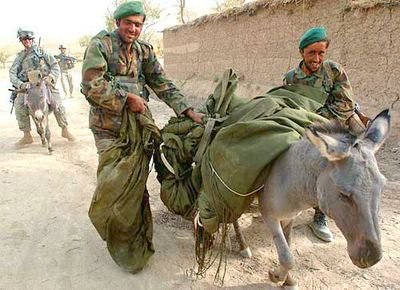
U.S. Army Staff Sgt. Matthew Sheppard (rear) and soldiers from the Afghan National Army use donkeys to transport air-dropped supplies back to their patrol base in Lwar Kowndalan, Afghanistan, Oct. 3, 2005. Sheppard is assigned to A Company, 1st Battalion, 325th Airborne Infantry Regiment. U.S. Army photo by Spc. Mike Pryor
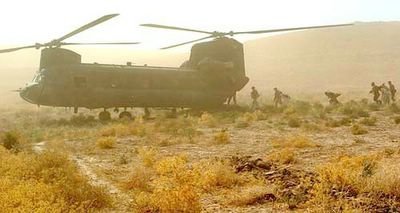
U.S. Army paratroopers load prisoners suspected of being Taliban operatives onto a Chinook transport helicopter to be taken in for questioning at a secure location, Oct. 2, 2005. The paratroopers are assigned to A Company, 1st Battalion, 325th Airborne Infantry Regiment. U.S. Army photo by Spc. Mike Pryor
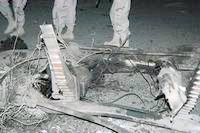
BAGHDAD � Monday evening�s suicide blasts in downtown Baghdad could have had a more devastating impact had it not been for the quick actions of Spc. Darrell Green.
Green, 38, a member of Company B, 3rd Battalion, 15th Infantry Regiment, 3rd Infantry Division, was pulling night guard duty at the Sheraton Hotel when he heard the first of three explosions. When he spotted a cement truck trying to wind its way to the hotel by driving through a hole blasted in a concrete wall, he reacted and shot at the truck.
The truck stopped, then exploded.
At the time, Green estimated, the truck was 100 feet from the hotel.
�He obviously had an itinerary to come in and do a lot of damage and cause casualties,� said Green, a native of Deland, Fla. �His intent was to get through and get into the [Palestine and Sheraton] hotels.�
Company B Commander Capt. John Newman disputed one theory, attributed to Iraqi officials, that the attack was part of a plan to kidnap journalists staying at the two hotels.
�I disagree with that assessment,� he said. �I honestly had to laugh when I read [that].�
Like Newman, Green said he thought the bomber�s intent was clear: to inflict as many casualties as possible.
�I don�t think he was trying to deliver flowers,� Green said.
Despite a number of civilian casualties, both men agreed that �this was a success story,� Newman said. �It could�ve been worse.�
�I really haven�t had a lot of sleep,� Green said. �A lot of things were on my mind.�
By Tuesday night, he returned to guard duty.
U.S. soldiers surveying the scene of Monday night�s bombings found large indentations in the pavement, scattered chunks of upholstery, twisted hunks of metal and unidentifiable car parts.
Utility poles, tree trunks and beams lay toppled or bent at crazy angles. Shards of glass from broken windows glittered all over the road. Damp patches on the road filled the evening air with the scent of gasoline. One of the explosions made shambles of an entire city block, reducing cars and a nearby strip mall to rubble.
Three suicide car bombers conducted the orchestrated attack in central Baghdad on Monday evening, destroying a city block. The Associated Press reported that Deputy Interior Minister Maj. Gen. Hussein Ali Kamal said 17 people were killed � mostly hotel guards and passers-by � and 10 wounded in the attack.
The attack occurred just as evening prayers were beginning at a nearby mosque and local Muslims prepared to break their Ramadan fast.
American officials � the area is under the purview of 2nd Brigade Combat Team, 3rd Infantry Division, of Fort Stewart, Ga. � said the coordinated attack was the first of its kind in several months. At the scene Monday night, soldiers waded solemnly through the debris and assessed the damage.
The 2nd Brigade deputy commander, Lt. Col. Edward Chesney, said he believed the attack, because of its proximity to media outlets, was an attempt to grab international headlines.
�This attack, from my perspective, is a cry for attention,� he said. �Nothing large has happened since [the Oct. 15 constitutional referendum]. Compared to some of the other things they�ve done, there wasn�t extensive casualties on Iraqis.�
Army officials say they�ll make efforts to help area businesses and residents rebuild after the attack.
�We�ll go down and try to help the shop owners whose shops were destroyed,� Chesney said. �We�ll bring in lumber to try to get their businesses back up. We�ll work with the Iraqi police to help clean up the area after the blast.�
Chesney said he was confident that the area, like others that have been hit by similar attacks, would rebound. He credited the Iraqi people with remarkable resiliency in the face of tragedy.
�The people will continue living, continue shopping, continue their Ramadan fast,� he said. �Life will go on.�
Iraqi officials at the scene expressed little surprise that the area, which is home to several national ministries, was chosen.
�This area has always been targeted,� said an Iraqi security forces worker, who asked not to be named or photographed for security reasons.
Shortly after the attack, a group of black-clad women congregated on the pavement at the scene and alternately wailed and screamed. U.S. Army officials refused to allow reporters on the scene to approach the civilians, who apparently were mourners.
The Associated Press reported Tuesday that Al-Qaida in Iraq has claimed responsibility for the attacks.

Kwinto, a military working dog with the 24th Marine Expeditionary Unit, sits beside his issued protective gear in the northern Babil province of Iraq Nov. 5, 2004. His gear includes a flak jacket, safety goggles and booties made for canines. Kwinto detects explosives at vehicle checkpoints, on security patrols and during weapon cache sweeps while deployed. U.S. Marine Corps photo by Cpl. Sarah A. Beavers

MARCHING CEREMONY � Iraqi Army 8th Division soldiers march in formation during a marching ceremony at the Iraqi 8th Division Headquarters, Iraq, Oct. 24, 2005. The ceremony is part of a demonstration of the Iraqi 8th Division's abilities for Iraqi, PAN-Arab and western media. U.S. Air Force photo by Senior Airman Patrick J. Dixon Hi-Res Photo
Wednesday, October 26, 2005
Avian flu epidemic set to spread to Africa and the Middle East next!
Will our troops bring it home, just like 1918 all over again!
The United Nations' Food and Agriculture Organization says birds could carry avian flu into the Middle East and east Africa within weeks. An article in Nature warns that the health and economic consequences could be even worse than for South East Asia. Middle Eastern states are monitoring migrating birds, and some African countries have banned poultry imports from parts of Asia hit by bird flu. Every new outbreak also increases the chance that the H5N1 virus could mutate to spread easily between humans and trigger a pandemic. If this happens, experts predict there could be anything between two million and 50 million deaths worldwide.
The United Nations' Food and Agriculture Organization says birds could carry avian flu into the Middle East and east Africa within weeks. An article in Nature warns that the health and economic consequences could be even worse than for South East Asia. Middle Eastern states are monitoring migrating birds, and some African countries have banned poultry imports from parts of Asia hit by bird flu. Every new outbreak also increases the chance that the H5N1 virus could mutate to spread easily between humans and trigger a pandemic. If this happens, experts predict there could be anything between two million and 50 million deaths worldwide.
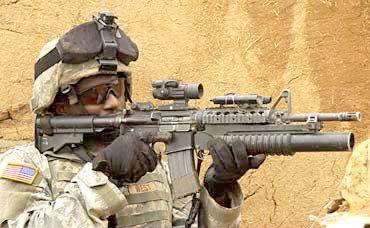
PROVIDING SECURITY � U.S. Army Sgt. Adrian West, assigned to the 172nd Stryker Brigade Combat Team, 2nd Battalion, 1st Infantry Regiment, Fort Wainwright, Alaska, looks through his aim point at a possible threat during house to house searching in Mosul, Iraq, Oct. 19, 2005. U.S. Air Force photo by Staff Sgt. James L. Harper
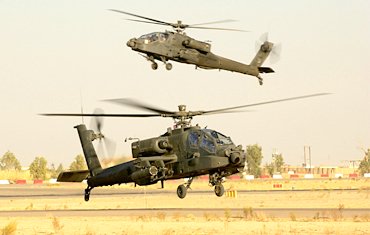
RETURN TO BASE � Two U.S. Army AH-64D Longbow Apache helicopters, assigned to the 1st Battalion, 101st Aviation Regiment, Fort Campbell Ky., return from another combat mission to Forward Operating Base Speicher, Iraq, Oct. 22, 2005, during Operation Iraqi Freedom. U.S. Air Force photo by Tech. Sgt. Andy Dunaway Hi-Res Photo
Tuesday, October 25, 2005
Last night I met a hero
Commentary by Maj. Mark Rasnake
332nd Expeditionary Medical Group
10/21/2005 - BALAD AIR BASE, Iraq (AFPN) -- I met a hero last night. I did not realize it at the time, but he is the closest thing to a hero that I likely will ever meet. This is a place where the word "hero" is tossed around day in and day out, so much so that you sometimes lose sight of its true meaning. His story reminded me of it.
He was commanding a Bradley fighting vehicle that was struck with a roadside bomb, catching fire. The loading ramp jammed, trapping eight inside. The crew was forced to escape through a much smaller hatch in the top of the vehicle. All but one made it out. The medic was left behind, apparently unable to get out. Without concern for his own life, my hero went back in to the burning vehicle to retrieve his friend.
Six of his buddies came to us with severe burns. He came to us with burns over most of his body, the most severely injured of the group.
The surgeons worked for hours on his wounds and we worked for hours in the intensive care unit to stabilize him for transport. In the end, damage to his lungs made him too sick to be safely transported by plane to our hospital in Germany and then on to a burn center in San Antonio.
The ventilators we use for transport simply could not deliver the amount of oxygen he needed. If he stayed here in Iraq he would have died of his wounds. We simply cannot care for such severe burns here. Only a handful of hospitals back in the U.S. can.
Knowing this, our air evac team loaded him into the plane for the six-hour flight to Germany. They had to deliver every breath to him during that flight by squeezing a small bag by hand. I do not know yet if he made it to Germany alive, or if he will be able to fly on to San Antonio.
Back home there is a bridge named for Sergeant Elbert Kinser. My grandfather told me the story about why the bridge was named for him. It came to my mind this morning. He was fighting alongside his buddies when the enemy threw a grenade into their ranks. Rather than attempt to run to escape the danger he threw himself on the grenade, saving the lives of his comrades. He was awarded the Medal of Honor for his gallantry, and the town named a bridge after him.
This is the story as I remember it being told to me. The details may be wrong. There is a memorial at the end of the bridge that tells Sergeant Kinser's actual story. Honestly, I do not think I have ever stopped to read it.
How many people drive across that bridge every day without ever wondering why it has its name? How many ever stop at the large parking area in front of the memorial to read the story of this man's last minutes on earth? How many of his friends are still alive to remember the story? How many grew old and had grandchildren because of his sacrifice? Did they thank him every day of their lives? The next time I cross that bridge I will stop for just a few minutes of my life to read about a man that gave all of his.
People use the word "hero" too much. We have cheapened it. We use it to describe football players and politicians. We even use it derisively at times to describe people we think are being too eager or self-promoting. It is even thrown about too cheaply over here when people describe groups of us just doing our jobs as "American Heroes."
Most of us will serve our time here with pride without ever truly earning that title. The man I met last night deserves to be called Hero. Years from now, will his friends remember what he did last night? Will I?
I have said it before and will say it again. It is a privilege to be here taking care of these troops. Are they all heroes? They certainly are more so than any athlete back home will ever be. There is a higher standard though even here. I was honored by seeing him in person last night.
332nd Expeditionary Medical Group
10/21/2005 - BALAD AIR BASE, Iraq (AFPN) -- I met a hero last night. I did not realize it at the time, but he is the closest thing to a hero that I likely will ever meet. This is a place where the word "hero" is tossed around day in and day out, so much so that you sometimes lose sight of its true meaning. His story reminded me of it.
He was commanding a Bradley fighting vehicle that was struck with a roadside bomb, catching fire. The loading ramp jammed, trapping eight inside. The crew was forced to escape through a much smaller hatch in the top of the vehicle. All but one made it out. The medic was left behind, apparently unable to get out. Without concern for his own life, my hero went back in to the burning vehicle to retrieve his friend.
Six of his buddies came to us with severe burns. He came to us with burns over most of his body, the most severely injured of the group.
The surgeons worked for hours on his wounds and we worked for hours in the intensive care unit to stabilize him for transport. In the end, damage to his lungs made him too sick to be safely transported by plane to our hospital in Germany and then on to a burn center in San Antonio.
The ventilators we use for transport simply could not deliver the amount of oxygen he needed. If he stayed here in Iraq he would have died of his wounds. We simply cannot care for such severe burns here. Only a handful of hospitals back in the U.S. can.
Knowing this, our air evac team loaded him into the plane for the six-hour flight to Germany. They had to deliver every breath to him during that flight by squeezing a small bag by hand. I do not know yet if he made it to Germany alive, or if he will be able to fly on to San Antonio.
Back home there is a bridge named for Sergeant Elbert Kinser. My grandfather told me the story about why the bridge was named for him. It came to my mind this morning. He was fighting alongside his buddies when the enemy threw a grenade into their ranks. Rather than attempt to run to escape the danger he threw himself on the grenade, saving the lives of his comrades. He was awarded the Medal of Honor for his gallantry, and the town named a bridge after him.
This is the story as I remember it being told to me. The details may be wrong. There is a memorial at the end of the bridge that tells Sergeant Kinser's actual story. Honestly, I do not think I have ever stopped to read it.
How many people drive across that bridge every day without ever wondering why it has its name? How many ever stop at the large parking area in front of the memorial to read the story of this man's last minutes on earth? How many of his friends are still alive to remember the story? How many grew old and had grandchildren because of his sacrifice? Did they thank him every day of their lives? The next time I cross that bridge I will stop for just a few minutes of my life to read about a man that gave all of his.
People use the word "hero" too much. We have cheapened it. We use it to describe football players and politicians. We even use it derisively at times to describe people we think are being too eager or self-promoting. It is even thrown about too cheaply over here when people describe groups of us just doing our jobs as "American Heroes."
Most of us will serve our time here with pride without ever truly earning that title. The man I met last night deserves to be called Hero. Years from now, will his friends remember what he did last night? Will I?
I have said it before and will say it again. It is a privilege to be here taking care of these troops. Are they all heroes? They certainly are more so than any athlete back home will ever be. There is a higher standard though even here. I was honored by seeing him in person last night.

By 2nd Brigade Combat Team Public Affairs
BAGHDAD, Iraq, Oct. 25, 2005 � An Iraqi Army raid on a suspected bomb-making factory in Baghdad resulted in the detention of 10 suspected terrorists Oct. 20. The 10 suspects were working in the facility when they were detained. They are now being processed by the Iraqi judicial system. The Iraqi Army set up an outer cordon around the building and launched the raid at midday. Within minutes, the entire building had been searched and cleared by the Iraqi Army forces.
"The Iraqi Army appeared very confident in the execution of this mission. They acted very professionally and took ownership of the operation. U.S. forces remained in the background while the [Iraqi Army] cleared the building." U.S. Army 1st Lt. Lauren Rowe
U.S. Army soldiers assigned to Task Force Baghdad then entered the cleared building and identified a truckload of materials used to make improvised explosive devices. An explosive ordnance disposal team followed and ensured it was safe to remove all the materials. "The Iraqi Army appeared very confident in the execution of this mission," said U.S. Army 1st Lt. Lauren Rowe, a military police officer in 2nd Brigade Combat Team, 3rd Infantry
Iraqi Army soldiers found boxes, bags and shelves filled with bomb-making materials in a factory in Baghdad, Iraq, Oct. 20, 2005. U.S. Army photo
A U.S. Army soldier assigned to Task Force Baghdad holds a triggering mechanism for a potential improvised explosive device. In a midday raid, Iraqi Army soldiers found boxes, bags and shelves filled with bomb-making materials in a factory in Baghdad, Iraq, Oct. 20, 2005. U.S. Army photo
Division. "They acted very professionally and took ownership of the operation. U.S. forces remained in the background while the [Iraqi Army] cleared the building." The Iraqi Army developed the intelligence on the target and planned the operation. "This operation shows that there are still caches to be discovered. We need the help of the Iraqi people to turn in suspects," Rowe said. "These materials could easily have been used by the terrorists to kill innocent Iraqi civilians," added U.S. Army Maj. Russ Goemaere, spokesperson for 2nd Brigade Combat Team. "The people of Baghdad need to feel a sense of pride that their army is performing so well and making the city safer for all of them
Officials Provide More Details of Baghdad Bombing
Officials Provide More Details of Baghdad Bombing
American Forces Press Service
WASHINGTON, Oct. 25, 2005 – Military officials today released more details about the three car bombs that detonated near the Palestine and Sheraton hotels in central Baghdad early Oct. 24.
Iraqi soldiers with the 8th Division pull security during an air assault exhibition Oct. 24 at Camp Echo, Iraq. This exhibition is part of a demonstration of the 8th Division's abilities for Iraqi, Middle Eastern and Western media. Photo by Senior Airman Patrick J. Dixon, USAF (Click photo for screen-resolution image);high-resolution image available.
The first car bomb caused a breach in an outer barrier wall of the Palestine and Sheraton hotels, at Firdos Square traffic circle, officials said.
About five minutes later, a second car bomb approached the square and tried to maneuver through the breach, but was engaged by civilian security forces and detonated near the 14th Ramadan Mosque.
Thirty seconds later, a Task Force Baghdad soldier engaged a cement truck that was moving through the breached wall. The truck exploded near a coalition vehicle, causing moderate damage.
At least six civilians were killed and 15 others were wounded in the attacks. No coalition forces were injured.
In other developments, two Marines assigned to Regimental Combat Team 8, 2nd Marine Division, 2nd Marine Expeditionary Force (Forward), were killed in action when their vehicle was attacked with an IED near Amariyah Oct. 21.
These two Marines are in addition to those announced in an Oct. 22 Multinational Force Iraq news release. Due to the circumstances of the incident, positive identification could not be made in time for earlier reporting, officials said. The attack killed a total of four servicemembers.
In addition, the initial release erroneously stated that two Marines had died. Further review shows that they were a Marine and a sailor.
The names of the deceased are being withheld pending notification of next of kin.
In other news from Iraq, coalition forces raided three suspected terrorist safe houses, detained six terrorists, and killed several others in Ushsh today.
Acting on multiple intelligence sources and tips from concerned citizens, coalition forces raided the safe houses, which were suspected to be terrorist strongholds used to conduct attacks against local Iraqi citizens, Iraqi security forces and coalition forces.
Upon arriving at the suspected terrorist safe house, coalition forces entered the house and found armed terrorists, women and children. In the ensuing gunfight, the suicide vest of one of the terrorists detonated, causing the building's roof to collapse. The women and children were rescued from the rubble and treated by medical personnel. The group was then moved to a safe area.
Coalition forces then moved to two other suspected safe houses and secured and searched them, detaining six terrorists. Upon leaving the terrorist stronghold, coalition forces called in close-air support and destroyed the three buildings.
Elsewhere, Task Force Baghdad soldiers sealed off a road in western Baghdad Oct. 24 after finding two large explosive devices rigged to explode. The patrol first reported finding an improvised explosive device in the median of the road. A short time later, they discovered another about 10 meters away.
To ensure the safety of the local residents along the busy road, the soldiers cordoned off the area and called in an explosives ordnance disposal team to take care of the IED. The EOD team recovered 12 60 mm mortar rounds with a timing device.
In other combat operations Oct. 23, a Task Force Baghdad patrol in northwestern Baghdad found an IED made up of a 152 mm round encased in a concrete block with wires protruding from the end. The soldiers detained a suspicious man who was mixing concrete nearby. Along with the incomplete IED, the patrol found two AK-47 assault rifles and 400 rounds of ammunition.
Another U.S. patrol west of Baghdad found an anti-tank mine wired to batteries in a plastic bag. An EOD team later destroyed the bomb.
Around the same time on Oct. 23, another Task Force Baghdad patrol on a combat mission found two 130 mm rounds rigged for remote-controlled detonation alongside a road north of Baghdad. EOD also disposed of that bomb.
(Compiled from Multinational Force Iraq news releases.)
American Forces Press Service
WASHINGTON, Oct. 25, 2005 – Military officials today released more details about the three car bombs that detonated near the Palestine and Sheraton hotels in central Baghdad early Oct. 24.
Iraqi soldiers with the 8th Division pull security during an air assault exhibition Oct. 24 at Camp Echo, Iraq. This exhibition is part of a demonstration of the 8th Division's abilities for Iraqi, Middle Eastern and Western media. Photo by Senior Airman Patrick J. Dixon, USAF (Click photo for screen-resolution image);high-resolution image available.
The first car bomb caused a breach in an outer barrier wall of the Palestine and Sheraton hotels, at Firdos Square traffic circle, officials said.
About five minutes later, a second car bomb approached the square and tried to maneuver through the breach, but was engaged by civilian security forces and detonated near the 14th Ramadan Mosque.
Thirty seconds later, a Task Force Baghdad soldier engaged a cement truck that was moving through the breached wall. The truck exploded near a coalition vehicle, causing moderate damage.
At least six civilians were killed and 15 others were wounded in the attacks. No coalition forces were injured.
In other developments, two Marines assigned to Regimental Combat Team 8, 2nd Marine Division, 2nd Marine Expeditionary Force (Forward), were killed in action when their vehicle was attacked with an IED near Amariyah Oct. 21.
These two Marines are in addition to those announced in an Oct. 22 Multinational Force Iraq news release. Due to the circumstances of the incident, positive identification could not be made in time for earlier reporting, officials said. The attack killed a total of four servicemembers.
In addition, the initial release erroneously stated that two Marines had died. Further review shows that they were a Marine and a sailor.
The names of the deceased are being withheld pending notification of next of kin.
In other news from Iraq, coalition forces raided three suspected terrorist safe houses, detained six terrorists, and killed several others in Ushsh today.
Acting on multiple intelligence sources and tips from concerned citizens, coalition forces raided the safe houses, which were suspected to be terrorist strongholds used to conduct attacks against local Iraqi citizens, Iraqi security forces and coalition forces.
Upon arriving at the suspected terrorist safe house, coalition forces entered the house and found armed terrorists, women and children. In the ensuing gunfight, the suicide vest of one of the terrorists detonated, causing the building's roof to collapse. The women and children were rescued from the rubble and treated by medical personnel. The group was then moved to a safe area.
Coalition forces then moved to two other suspected safe houses and secured and searched them, detaining six terrorists. Upon leaving the terrorist stronghold, coalition forces called in close-air support and destroyed the three buildings.
Elsewhere, Task Force Baghdad soldiers sealed off a road in western Baghdad Oct. 24 after finding two large explosive devices rigged to explode. The patrol first reported finding an improvised explosive device in the median of the road. A short time later, they discovered another about 10 meters away.
To ensure the safety of the local residents along the busy road, the soldiers cordoned off the area and called in an explosives ordnance disposal team to take care of the IED. The EOD team recovered 12 60 mm mortar rounds with a timing device.
In other combat operations Oct. 23, a Task Force Baghdad patrol in northwestern Baghdad found an IED made up of a 152 mm round encased in a concrete block with wires protruding from the end. The soldiers detained a suspicious man who was mixing concrete nearby. Along with the incomplete IED, the patrol found two AK-47 assault rifles and 400 rounds of ammunition.
Another U.S. patrol west of Baghdad found an anti-tank mine wired to batteries in a plastic bag. An EOD team later destroyed the bomb.
Around the same time on Oct. 23, another Task Force Baghdad patrol on a combat mission found two 130 mm rounds rigged for remote-controlled detonation alongside a road north of Baghdad. EOD also disposed of that bomb.
(Compiled from Multinational Force Iraq news releases.)
Sunday, October 23, 2005

STRYKER SEARCH � U.S. Army Staff Sgt. Paul Volino of the 172nd Stryker Brigade Combat Team, Second Battalion, 1st Infantry Regiment, Ft. Wainwright, Alaska talks to an Iraqi man during a search in Mosul, Iraq, Oct. 19, 2005. U.S. Air Force photo by Staff Sgt. James L. Harper Jr. Hi-Res Photo
Iraq Operations Net Multiple Suspects
WASHINGTON, Oct. 23, 2005� Coalition and Iraqi forces nabbed 31 suspects and discovered several bombs in operations across Iraq conducted between Oct. 21 and today. During raids on safe houses, coalition forces killed two suspected terrorists in Mosul on Oct. 22, and detained 22 others near Ramadi today. Story
Troops Injured in Hard Chopper Landing
WASHINGTON, Oct. 23, 2005� Four servicemembers were injured when their UH-60 Black Hawk helicopter made a hard landing during combat operations in Afghanistan's Oruzgan province on Oct. 22, officials reported today. Story
Secretary Urges Resolution of Allegations
VILNIUS, Lithuania, Oct. 22, 2005 � Allegations like those lodged this week against soldiers in Afghanistan accused of mistreating Taliban fighters' dead bodies - whether true or not - can cause tremendous harm to the United States and need to be resolved quickly, Defense Secretary Donald Rumsfeld said. Story
Rumsfeld Thanks Mongolian Army Soldiers
ULAANBAATAR, Mongolia, Oct. 22, 2005 � A group of almost 200 Mongolian Army soldiers got a personal thank you from U.S. Defense Secretary Donald Rumsfeld. Story | Photos
Rumsfeld's Mongolia Visit Focuses on Peacekeeping
U.S. Troops Die in Iraq; Insurgents Killed
WASHINGTON, Oct. 22, 2005 � Three Marines were killed in two combat operations in Iraq on Oct. 21. During the subsequent engagement, Marines killed four insurgents and destroyed a bunker adjacent to their position. Story
Bush: Islamic Radicalism 'Doomed to Fail'
WASHINGTON, Oct. 21, 2005 � Evoking President Ronald Reagan's leadership of America's resolve in confronting communism during his two terms in office, President Bush said today that Islamic radicalism is doomed to fail as communism did. Story | Remarks
Baghdad Raids Helped Preempt Attacks
WASHINGTON, Oct. 21, 2005 � Preemptive raids conducted by U. S. , other coalition and Iraqi forces in and around the Iraqi capital before the Oct. 15 referendum helped limit insurgent attacks on voting day, the U. S. military commander for troops in Baghdad said today. Story | Video
STRYKER SEARCH � U.S. Army Staff Sgt. Paul Volino of the 172nd Stryker Brigade Combat Team, Second Battalion, 1st Infantry Regiment, Ft. Wainwright, Alaska talks to an Iraqi man during a search in Mosul, Iraq, Oct. 19, 2005. U.S. Air Force photo by Staff Sgt. James L. Harper Jr. Hi-Res Photo
Iraq Operations Net Multiple Suspects
WASHINGTON, Oct. 23, 2005� Coalition and Iraqi forces nabbed 31 suspects and discovered several bombs in operations across Iraq conducted between Oct. 21 and today. During raids on safe houses, coalition forces killed two suspected terrorists in Mosul on Oct. 22, and detained 22 others near Ramadi today. Story
Troops Injured in Hard Chopper Landing
WASHINGTON, Oct. 23, 2005� Four servicemembers were injured when their UH-60 Black Hawk helicopter made a hard landing during combat operations in Afghanistan's Oruzgan province on Oct. 22, officials reported today. Story
Secretary Urges Resolution of Allegations
VILNIUS, Lithuania, Oct. 22, 2005 � Allegations like those lodged this week against soldiers in Afghanistan accused of mistreating Taliban fighters' dead bodies - whether true or not - can cause tremendous harm to the United States and need to be resolved quickly, Defense Secretary Donald Rumsfeld said. Story
Rumsfeld Thanks Mongolian Army Soldiers
ULAANBAATAR, Mongolia, Oct. 22, 2005 � A group of almost 200 Mongolian Army soldiers got a personal thank you from U.S. Defense Secretary Donald Rumsfeld. Story | Photos
Rumsfeld's Mongolia Visit Focuses on Peacekeeping
U.S. Troops Die in Iraq; Insurgents Killed
WASHINGTON, Oct. 22, 2005 � Three Marines were killed in two combat operations in Iraq on Oct. 21. During the subsequent engagement, Marines killed four insurgents and destroyed a bunker adjacent to their position. Story
Bush: Islamic Radicalism 'Doomed to Fail'
WASHINGTON, Oct. 21, 2005 � Evoking President Ronald Reagan's leadership of America's resolve in confronting communism during his two terms in office, President Bush said today that Islamic radicalism is doomed to fail as communism did. Story | Remarks
Baghdad Raids Helped Preempt Attacks
WASHINGTON, Oct. 21, 2005 � Preemptive raids conducted by U. S. , other coalition and Iraqi forces in and around the Iraqi capital before the Oct. 15 referendum helped limit insurgent attacks on voting day, the U. S. military commander for troops in Baghdad said today. Story | Video
Friday, October 21, 2005

Vehicle Fire, Roadside Bomb Claim Soldiers' Lives
American Forces Press Service
WASHINGTON, Oct. 20, 2005 � Five more U.S. soldiers have died in Iraq, military officials in Baghdad reported.
A Task Force Liberty soldier was killed and four others were wounded when their vehicle caught fire near Tikrit, and three Task Force Liberty soldiers were killed and another was wounded when their combat patrol struck a roadside bomb near Balad. Both incidents occurred Oct. 19.
The wounded soldiers were taken to coalition forces medical facilities for treatment, but no report on their condition was available.
A soldier assigned to Regimental Combat Team 2, 2nd Marine Division, 2nd Marine Expeditionary Force (Forward), died from what officials described as "a non-hostile gunshot wound" on Oct. 18 at a forward operating base near Mosul.
The soldiers' names are being withheld pending notification of next of kin.
In other news from Iraq, Task Force Baghdad soldiers found and destroyed terrorists' bombs and weapons caches during combat operations Oct. 19 in and around various Baghdad districts.
The soldiers found at least eight improvised explosive devices before terrorists could detonate them. One patrol also discovered a cache of about 600 sticks of commercial explosives in a pickup truck in southern Baghdad. An explosive ordnance disposal team collected the explosives for later destruction.
In one of the biggest discoveries of the day, a Task Force Baghdad unit operating in southern Baghdad found a 250-pound aerial bomb with detonation cord. The unit requested EOD assistance and, a short time later, reported finding another IED consisting of a 125 mm and a 120 mm round. EOD performed a controlled detonation on both IEDs.
An informant's tip led a U.S. patrol northwest of Baghdad to another IED on Oct. 19. The soldiers found a 155 mm and a 60 mm round along the side of a road. EOD was called in to destroy that IED as well.
A senior Abu Musab al-Zarqawi lieutenant and al Qaeda military leader in Iraq was killed during a series of coalition raids in western Iraq on Oct. 15, military officials announced today.
Coalition forces conducted the raids on suspected terrorists operating near the town of Ramadi, officials said. At least 12 terrorists were killed during the raids. Recently captured detainees identified one of the dead terrorists as Saad Ali Firas Muntar al-Dulaymi, also known as Abu Abdullah.
Intelligence sources indicate that Dulaymi was highly regarded by many senior al Qaeda terrorists in Iraq, including Zarqawi himself. He is believed to have facilitated high-level meetings in Ramadi and Fallujah, where senior-level terrorists gathered to discuss strategy and ongoing operations. Zarqawi was said to have attended some of these meetings.
Dulaymi quickly ascended the ranks and supposedly worked with Zarqawi's lieutenant Abu Qutaiba in a vehicle smuggling network originating in Jazirah, near Fallujah, prior to Qutaiba's capture by coalition forces. He then ran his own smuggling organization funding bomb making operations in the Fallujah and Ramadi areas, officials said, adding he was chiefly responsible for planning and executing all terrorist attacks on Iraqi and coalition forces in the Ramadi and Fallujah areas.
In other news from Iraq, Iraqi and coalition forces conducted 42 raids and searches in and around Baghdad that netted 19 terror suspects and two weapons caches Oct. 16 through Oct. 18.
In the three days following Iraq's historic constitutional referendum vote, Iraqi and U.S. forces combined to conduct more than 1,600 patrols and man more than 700 traffic control points. Iraqi security forces performed more than 1,000 of the nearly 2,400 missions by themselves and teamed up with U.S. soldiers on more than 100 others, officials said.
One of the largest combat operations was carried out by Iraqi soldiers from 1st Battalion, 2nd Brigade, 6th Iraqi Army Division, Oct. 18. Just after midnight, Iraqi soldiers captured five terror suspects during a raid against a terrorist safe house in the Adhamiyah district of central Baghdad.
Many of the operations were based on tips from Iraqi citizens tired of terrorist violence in their neighborhoods, officials said.
One tip helped Task Force Baghdad soldiers from the 70th Engineer Brigade seize three suspected bombers during a cordon-and-search operation in northern Baghdad on Oct. 18. The three men are thought to be involved in placing roadside bombs targeting Iraqi security forces, coalition forces and civilians in the area.
Later in the morning, a second citizen's tip helped coalition forces capture a suspected weapons dealer and terrorist organization financier during a search of two houses in northern Baghdad.
Two days earlier, Task Force Baghdad soldiers acted on another citizen's tip to seize a large weapons cache in western Baghdad. When the soldiers of the 48th Brigade Combat Team searched the area, they found a weapons cache consisting of 103 high-explosive rounds, 151 mortar rounds, six mortar tubes, 31 mortar fuses, five mortar base plates, two mortar tripods and a mortar-sighting device.
The cache also contained two anti-tank weapons, an anti-aircraft machine gun, 10 sticks of dynamite, 25 grenades, a machine gun, four rifles, sniper scopes, a silencer, 8,000 rounds of ammunition, and bomb-making materials. Three suspects at the site were detained for questioning.
(Compiled from Multinational Force Iraq news releases.)
Thursday, October 20, 2005
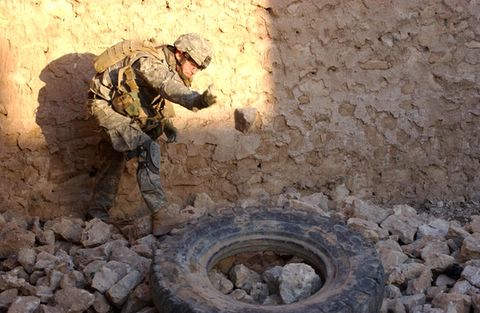
A local resident insists troops missed some weapons during an initial search; a subsequent search yields weapons buried beneath rocks and soil.
By U.S. Army Pfc. James Wilt 82nd Airborne Division
TALL AFAR, Iraq, Oct. 19, 2005 � U.S. Army paratroopers from Company B, 2nd Battalion, 325th Airborne Infantry Regiment, 82nd Airborne Division, and Company B, 307th Engineer Battalion, 82nd Airborne Division, uncovered a cache of weapons during a raid on a house here, Oct. 18. The combined unit unearthed seven assault rifles, one medium machine gun, six hand grenades, three anti-aircraft rounds modified for use as hand grenades, seven ammunition vests, over 2,500 rounds of ammunition, 30 magazines and materials thought to be used to make improvised explosive devices.
"Look at all the stuff that we found, how many lives we probably saved." U.S. Army Pfc. Valentino R. Cuellar
Working off of a tip from a local resident, the paratroopers searched the house Oct. 17 in an effort to uncover any weapons there. Three assault rifles and two ammunition vests were found during the initial search, said U.S. Army Staff Sgt. Jason R. Gillis, an infantryman with Company B, 2nd Battalion, 325th Airborne Infantry Regiment. The informant who gave the unit the tip approached the paratroopers a second time to tell them that he believed there were still more weapons inside the house, Gillis, a native of Goldsboro, N.C., said. Again following the lead from the informant, the troopers returned to the house Oct. 18 armed with a metal detector and digging tools. Once in the target room, the unit's metal detector didn't find anything beneath the stone lined floor, said U.S. Army Spc. Christopher L. Sharp, a combat engineer, with Company B, 307th Engineer Battalion.
Undeterred, Sharp and U.S. Army Pfc. Valentino R. Cuellar, also a combat engineer, began moving rocks to search for any recently moved soil, Sharp, a Dallas native, said. Picking up a rock by the doorway, Sharp said he noticed the dirt was not packed down like the rest of the floor. After removing more rocks, Sharpe found a barrel buried in the dirt. Inside of the barrel was the largest cache Company B has found in their sector, Sharp said. The paratroopers removed the weapons and filled in the hole were the cache was buried. Moving on to search the rest of the house and surrounding area, the soldiers found electronic devices believed to be used for making improvised explosive devices. No detainees were taken as the house was unoccupied. The raid was part of the 82nd Airborne Division's efforts to make the streets here safer for the Iraqi people. "Look at all the stuff that we found, how many lives we probably saved," said Cuellar, a native of Los Angeles. The paratroopers will remain in the city for an undetermined amount of time and will continue to conduct operations here in an attempt to maintain stability in the region.

Soldier Killed; Iraq Operations Net Weapons, Suspects
American Forces Press Service
WASHINGTON, Oct. 19, 2005 � A U.S. soldier was killed and two others were wounded in a roadside-bomb during a combat logistics patrol Oct. 18 near Iskandariyah, Iraq, military officials reported.
The soldier killed was assigned to 56th Brigade Combat Team. The soldier's name is being withheld pending notification of family.
In other news, Task Force Baghdad and Iraqi security forces discovered weapons caches and detained several suspects Oct. 18 and today.
Today, soldiers assigned to 3rd Battalion, 7th Infantry Regiment, conducted a raid in Camel, detaining three terror suspects. They also confiscated ammunition and explosives, including 3,000 rounds of assorted 7.2 mm and 9 mm ammunition, 12 full AK-47 rifle magazines, and materials to make improvised explosive devices. The detainees are suspected of selling IEDs and weapons in the area.
Elsewhere, a special tactics unit detained three suspected terrorists in a raid in Saydiyah today.
In addition, soldiers from 1st Battalion, 184th Infantry Regiment, 4th Brigade Combat Team, joined Iraqi commandos from 1st Battalion, 2nd Commando Brigade, to conduct a raid in Dora, in southern Baghdad, on the evening of Oct. 18.
The target house held six terrorists suspected of conducting rocket-propelled-grenade attacks on Iraqi security force checkpoints. The U.S. soldiers provided the outer cordon while Iraqi forces conducted the raid.
Elsewhere in Baghdad, Iraqi security forces and Task Force Baghdad soldiers captured a terror suspect in southern Baghdad, seized a weapons cache in western Baghdad, and stopped eight terrorist bomb attacks. Tips from Iraqi citizens helped one patrol find the weapons cache and another unit disable a roadside bomb before terrorists could use it.
The first tip came from an Iraqi man who told Iraqi security forces from 1st Battalion, 4th Public Order Brigade, that he'd seen a bomb in a southern Baghdad district. The Iraqi forces investigated and found five mortar rounds wired together. They stopped traffic in both directions as a safety precaution, and a team of explosives experts safely detonated the bomb.
U.S. soldiers from 3rd Battalion, 3rd Armored Cavalry Regiment, also detained a man acting suspiciously at a traffic control point in southern Baghdad. When the soldiers searched the suspect, they found paperwork concerning an improvised explosive device or ammunitions cache. The suspect was detained for questioning.
Later, another Iraqi citizen volunteered to lead coalition forces from 2nd Battalion, 22nd Infantry Regiment, to a weapons cache in western Baghdad. The unit discovered a cache containing 10 rocket-propelled-grenade rounds and numerous 60 mm mortar rounds.
Other coalition forces found seven roadside bombs at various locations throughout Baghdad before terrorists could use them. Explosive ordnance disposal teams safely disabled each of the bombs.
In other news from Iraq, U.S. soldiers from Task Force Liberty followed a civilian tip to a cache of 85 anti-tank mines near Hamrin, in Diyala province.
A local citizen was digging in the area when he uncovered the munitions and immediately reported it to coalition forces. The anti-tank mines discovered are of the same type recently used in IED attacks. Task Force Liberty explosive ordnance personnel removed the munitions for future disposal.
Also on Oct. 18, coalition forces destroyed a terrorist safe house in Karabala, where two al Qaeda terror cells were attempting to meet and reorganize following successful coalition operations.
Coalition air forces delivered precision-guided munitions that destroyed the terrorist safe house. The type of munitions used and the timing of the air strike mitigated the risk to civilians in the local area, according to U.S. officials.
Multiple intelligence sources had identified the terrorist safe house, which was used as both an operational base and safe haven.
In the skies over Iraq, coalition aircraft flew 46 close-air-support and armed-reconnaissance sorties Oct. 18 in support of Operation Iraqi Freedom.
These missions included support to coalition troops, infrastructure protection, reconstruction activities, and operations to deter and disrupt terrorist activities. Coalition aircraft also supported Iraqi and coalition ground forces operations to create a secure environment for ongoing Transitional National Assembly meetings.
U.S. Air Force F-16s performed a successful air strike against an improvised explosive device-staging area near Tikrit, expending GBU-38 and GBU-12 500-pound bombs. U.S. Navy F/A-18s performed a successful air strike against a building used by insurgents in the vicinity of Karabala, expending one GBU-38.
Other sorties included U.S. Air Force F-16s and F-15s and U.S. Navy F/A-18s, which provided close-air support to coalition troops near Hawijah, Baghdad, Basrah, Bayji, Mosul and Tikrit. The Air Force and Navy also provided 13 intelligence, surveillance and reconnaissance aircraft that flew missions in support of OIF operations. Also, U.S. Air Force fighter aircraft performed in a nontraditional ISR role with their electro-optical and infrared sensors.
